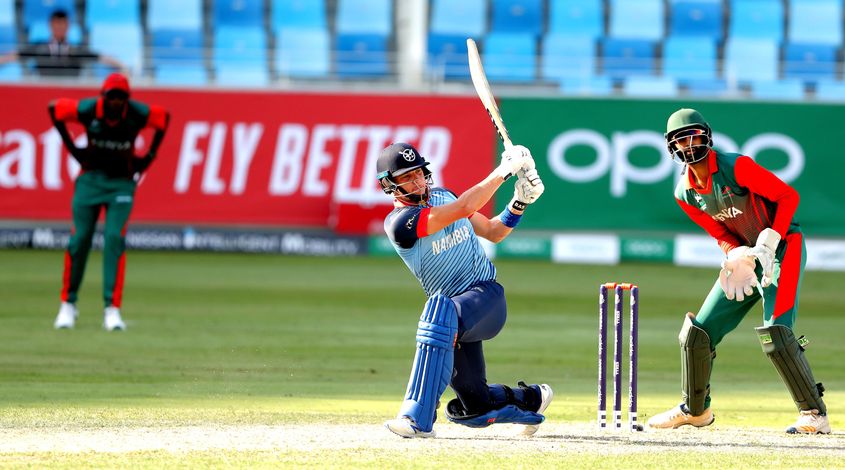Sharp eyes, soft hands, quick feet
There are very few good batsmen against spin.
Playing spin is difficult and takes practice, but good spinners are rare, so batsmen don’t get to face them much in the nets or in matches. The result is batsman who can defend or slog, with not much in-between.
So how do you improve your play against spin?
The easiest way to develop a game-plan is to treat playing spin techniques while keeping in mind risk vs. reward.
Tips for playing spin
- Play Straight – Reading it from the hand. Watch the ball/hand/fingers
- Use your Feet – Play forward or back. Have a solid base to play from. Playing late. Keep the ball on the ground.
- Sweep – Pushing the fielder back and sweeping. Keep the head still
- Improvise – Body-weight transfer. Play forward or back. Use the forward press, not halfway. Positive use of the feet.
- Play straight

The underlying principle of playing spin is always the same: first play with the spin using the full face of the bat.
That means driving with a high elbow on the front and back foot. You have a choice of how you do it: into the spin, or with the spin.

- Into the spin: the ball spinning into the stumps can be met by the full face of the bat when you hit through the off side because more of the ball and more of the bat will come into contact with each other.
- With the spin: Uses the natural angle of the ball against a straight bat to hit it into the same side as its turning.
So, safe shots are:
- Ball turning in: drive/flick between midwicket and mid off, drive between mid off and extra cover.
- Ball turning away: Drive between cover and straight mid on, Drive through midwicket (front and back foot).

Wait for the over pitched or slightly short ball, get in position and swing the bat through the line towards the target area. Simply playing like this will get you plenty of runs without having to do anything else.

- Use your feet

Now imagine the spinner is tying you down enough so you are behind the rate.
The first tactic is to use your feet to move down the wicket and turn a good length ball into a half volley that you can drive straight. This is riskier than staying in your crease because if you miss it you can be stumped, but because you are still playing straight you can pick up runs in your chosen scoring area (which hasn’t changed).
3.Sweep

Sweeping is a riskier way to score against tight bowling because you are playing across the line, which is why it’s third in your list of options.
If the mid on and mid off are back and the ring fielders are tying you down then the sweep is a handy option to manipulate the field. It’s best played against a bowler pitching the ball on or outside leg stump with the ball turning away (for example left arm over to a right hander) because LBW is out of the picture.

You can also sweep to the ball turning in if you hit it square.
If you are right-handed the riskiest sweep is the off-spinner bowling around the wicket (for left handers the risk is the left arm round bowler). This is because if the ball straightens and hits you in line you are likely to be out LBW.
This Diagram Shows How Some Spinners May Try To Land The Ball Outside Leg Stump & Spin The Ball Across You
- Improvise

If you are looking to score quickly and off almost every ball (say at the death of a one day innings) you must take risks, however you can still look to score in safer areas, even when you are hitting sixes.
One way of doing this is the modern “forward press” of taking a small step onto your front foot just before the delivery. This means you have the option to move down the wicket and hit straight, or to go deep in the crease on the back foot and drive or pull.

To the ball moving away you also have the option of cutting and late cutting safely if you are deep in the crease.

Other improvising options are:
- Ball turning in: Move the front leg out to the leg side, opening yourself up to hit the ball over mid on or midwicket if it’s full or square leg if it’s on a length with a slog sweep.
- Ball turning away: If the line is leg side you can sweep, or slog sweep the ball over midwicket. A straighter line means you can move down the wicket and hit with the spin over extra cover, going ‘inside out’.
The trick to playing spin well is to not try and move up your options unless you must. If you can score at the required rate by sticking with number 1 then why take additional risks?
This is especially true if you have little practice time against decent spin. Focus on the basics of 1 and 2 then, if you have more time, start practicing 3 and 4.
Playing spin is difficult and takes practice, but good spinners are rare, so batsmen don’t get to face them much in the nets or in matches
Conclusion
The most important part of improving your batting against spin is experience. You need to be in the nets facing spin bowlers regularly. If you can do that, then that is a great platform.



